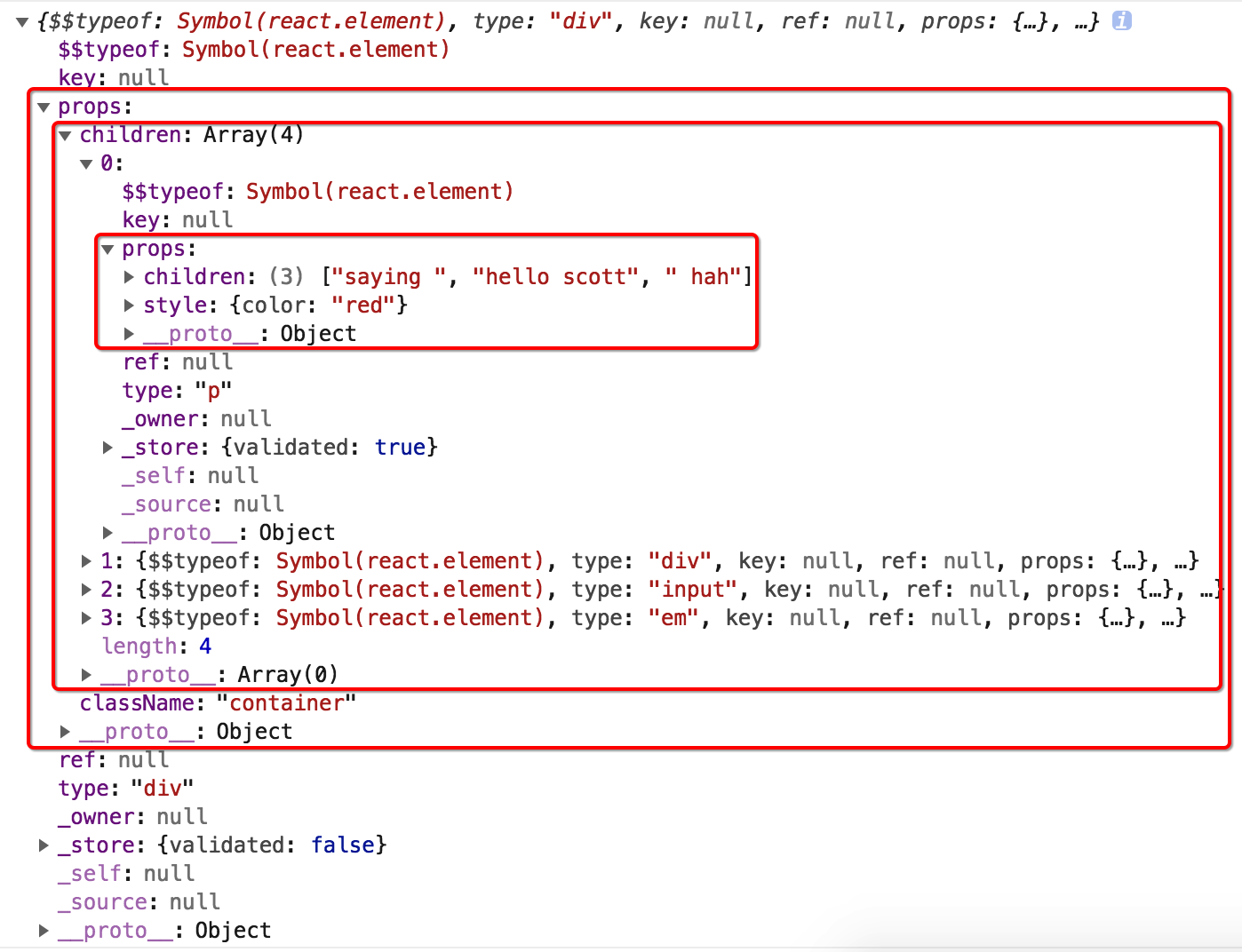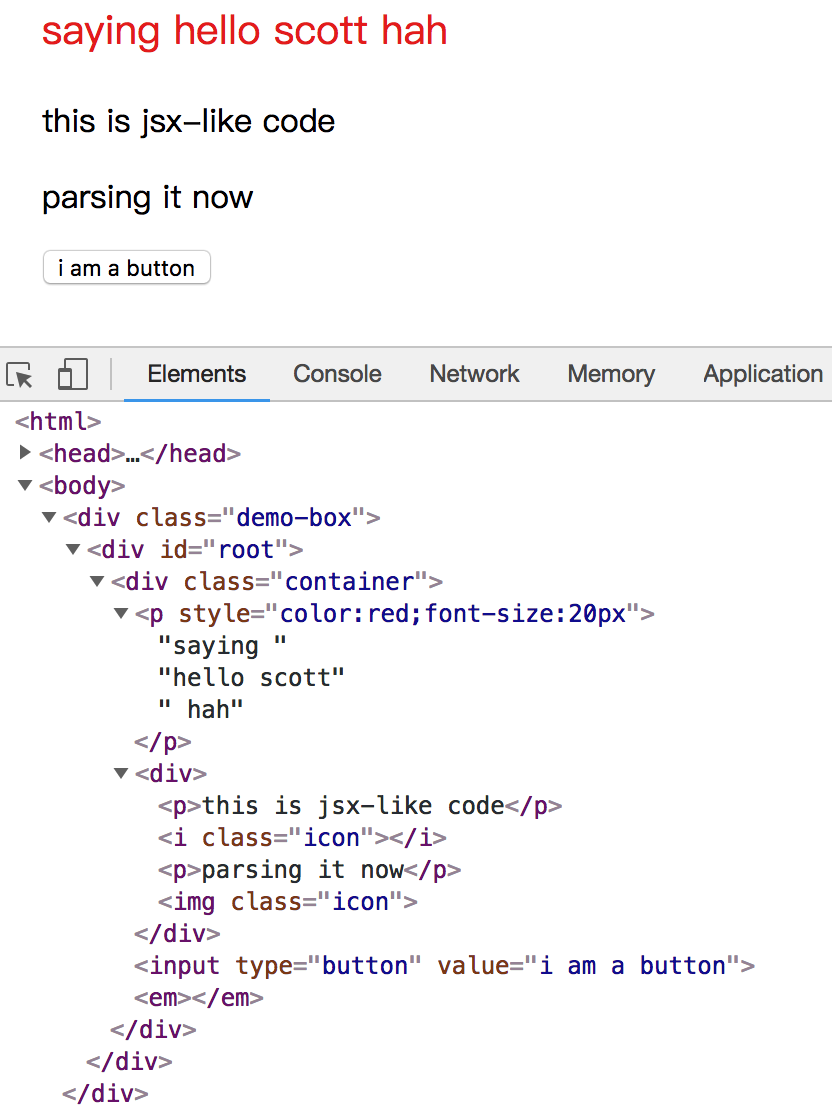在上一篇文章中,我们介绍了Babel是如何将JSX代码转译成可执行代码的,随后也实现了一个自己的解析器,模拟了Babel转译的过程。
现在我们再来回顾一下,假如有如下业务代码:
const style = {
color: 'red',
fontSize: '20px',
};
const greet = function (name) {
return `hello ${name}`;
};
const App = (
<div className="container">
<p style={style}>saying {greet('scott')} hah</p>
<div>
<p>this is jsx-like code</p>
<i className="icon"/>
<p>parsing it now</p>
<img className="icon"/>
</div>
<input type="button" value="i am a button"/>
<em/>
</div>
);
console.log(App);
ReactDOM.render(App, document.getElementById('root'));经过转译之后,会生成下面的可执行代码:
var style = {
color: 'red',
fontSize: '20px'
};
var greet = function greet(name) {
return 'hello ' + name;
};
var App = React.createElement(
'div',
{ className: 'container' },
React.createElement(
'p',
{ style: style },
'saying ',
greet('scott'),
' hah'
),
React.createElement(
'div',
null,
React.createElement(
'p',
null,
'this is jsx-like code'
),
React.createElement('i', { className: 'icon' }),
React.createElement(
'p',
null,
'parsing it now'
),
React.createElement('img', { className: 'icon' })
),
React.createElement('input', { type: 'button', value: 'i am a button' }),
React.createElement('em', null)
);
console.log(App);
ReactDOM.render(App, document.getElementById('root'));引入所需的React库:
<!DOCTYPE html>
<html>
<body>
<div id="root"></div>
<script crossorigin src="https://unpkg.com/react@16/umd/react.production.min.js"></script>
<script crossorigin src="https://unpkg.com/react-dom@16/umd/react-dom.production.min.js"></script>
<script src="index.js"></script>
</body>
</html>运行以上代码,我们会发现控制台打印信息如下图所示:

从图中可以看出,type就是标签名,其他字段比较常用的有key、ref以及props,其中props中会包含className、style和children等字段。这些信息最终会映射成真实的DOM节点,所以这些就是我们熟知的Virtual DOM,而ReactDOM.render()函数就是将虚拟DOM转换成真实的DOM。
我们现在可以得出一个结论,React.createElement()负责根据代码生成虚拟DOM,ReactDOM.render()负责将虚拟DOM映射到真实DOM上。
究竟React.createElement()和ReactDOM.render()是如何将程序转换成真实DOM的呢?接下来,我们就来试着实现React.createElement()和ReactDOM.render()的逻辑。
先来实现React.createElement()方法:
const React = {
// 创建DOM描述对象 即虚拟DOM
createElement(tag, attrs, ...children) {
let vnode = {
type: tag,
props: {
...attrs,
children: [],
}
};
children.forEach(child => {
vnode.props.children.push(child);
});
return vnode;
}
};以上代码会生成下面的虚拟DOM结构:

然后是ReactDOM.render()方法:
const ReactDOM = {
// 渲染真实DOM
render(vnode, container) {
let realDOM = this.generateDOM(vnode);
container.appendChild(realDOM);
},
// 获取真实DOM
generateDOM(vnode) {
let elem = document.createElement(vnode.type);
// 特殊key值映射
let specialKeyMap = {
className: 'class',
fontSize: 'font-size',
};
let {props} = vnode;
// 设置DOM属性
props && Object.keys(props).forEach(key => {
if (key === 'children') {
// 处理子节点
props.children.forEach(child => {
if (typeof child === 'string') {
// 纯内容节点
elem.appendChild(document.createTextNode(child));
} else {
// DOM节点
elem.appendChild(this.generateDOM(child));
}
});
} else if (key === 'style') {
// 设置样式属性
let styleObj = props.style;
let styleItems = [];
Object.keys(styleObj).forEach(styleKey => {
styleItems.push(`${specialKeyMap[styleKey] || styleKey}:${styleObj[styleKey]}`);
});
elem.setAttribute('style', styleItems.join(';'));
} else {
// 设置其他属性
elem.setAttribute(specialKeyMap[key] || key, props[key]);
}
});
return elem;
}
};最后我们把前面引用的React库替换成上面我们自己实现的代码,然后运行,见证奇迹的时刻到了:

只需两段简短的代码,我们就生成了一个迷你版的虚拟DOM,并最终生成了真实的DOM结构,是不是很简单?当然,React所实现的功能远不止这些,我们后续会继续介绍。